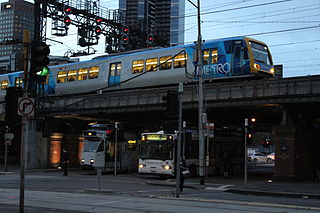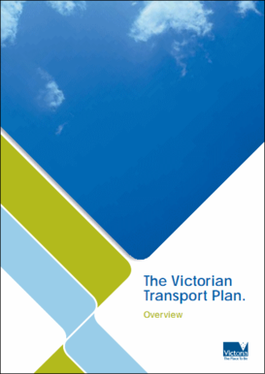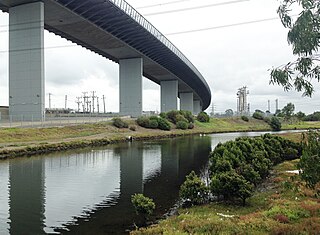Related Research Articles

Proposals for expansion of the Melbourne rail network are commonly presented by political parties, government agencies, industry organisations and public transport advocacy groups. The extensions proposed take a variety of forms: electrification of existing routes to incorporate them into the suburban rail system; reconstruction of former passenger rail lines along pre-existing easements; entirely new routes intended to serve new areas with heavy rail or provide alternative routes in congested areas; or track amplification along existing routes to provide segregation of services. Other proposals are for the construction of new or relocated stations on existing lines, to provide improved access to public transport services.

The Cranbourne line is a commuter railway line in the city of Melbourne, Victoria, Australia. Operated by Metro Trains Melbourne, it is the city's second longest metropolitan railway line at 44 kilometres (27.34 mi). The line runs from Flinders Street station in central Melbourne to Cranbourne station in the south-east, serving 24 stations via the City Loop, South Yarra, Caulfield, Oakleigh, and Dandenong. The line operates for approximately 20 hours a day with 24 hour service available on Friday and Saturday nights. During peak hour, headways of up to 5 to 15 minutes are operated with services every 15–20 minutes during off-peak hours. Trains on the Cranbourne line run with a seven-car formation operated by High Capacity Metro Trains.

Victoria has the highest density of roads of any state in Australia. Unlike Australia's other mainland states where vast areas are very sparsely inhabited, Victoria has population centres spread out over most of the state, with only the far north-west and the Victorian Alps without permanent settlement. Population centres are linked by high quality highways and freeways. The state capital, Melbourne, has the most extensive freeway network of any city in Australia.

The Eastern Freeway is an urban freeway in eastern Melbourne, the state capital of Victoria, Australia. It is one of the most important freeways in terms of commuting to the city, connecting Alexandra Parade and Hoddle Street in the inner suburbs, with EastLink tollway farther east. It consists of between three and six lanes in each direction, also an inbound transit lane reserved for vehicles with two or more occupants during peak hours.

John Mansfield Brumby is the current Chancellor of La Trobe University and former Victorian Labor Party politician who was Premier of Victoria from 2007 to 2010. He became leader of the Victorian Labor Party and premier after the resignation of Steve Bracks. He also served as the Minister for Veterans' Affairs and the Minister for Multicultural Affairs. He contested his first election as premier at the November 2010 Victorian state election. His government was defeated by the Liberal/National Coalition led by Ted Baillieu. Brumby resigned as Labor leader after the election, on 30 November, to be replaced by Daniel Andrews. Within weeks of this leadership change, Brumby left parliament, with a Broadmeadows by-election taking place on 19 February 2011.

Transport in Melbourne, the state capital of Victoria, Australia, consists of several interlinking modes. Melbourne is a hub for intercity, intracity and regional travel. Road-based transport accounts for most trips across many parts of the city, facilitated by Australia's largest freeway network. Public transport, including the world's largest tram network, trains and buses, also forms a key part of the transport system. Other dominant modes include walking, cycling and commercial-passenger vehicle services such as taxis.

Leongatha is a railway station in the town of Leongatha, Victoria on the former South Gippsland railway line in South Gippsland, Victoria, Australia.

Lynne Janice Kosky was an Australian politician and senior minister in the Government of Victoria. She represented the electoral district of Altona in the Victorian Legislative Assembly for the Labor Party from 1996 to 2010 and held key ministerial posts from 1999 through to her retirement from politics, including the key education and public transport portfolios.
The Victorian Transport Study, better known as the Lonie Report, was an extensive study of freight and passenger transport within the state of Victoria, Australia. The study was set up on 13 June 1979 by the Government of Victoria, and the report was published on 26 September 1980.

The Doncaster railway line was a long-proposed suburban railway in the eastern suburbs of Melbourne, Victoria, Australia, that was anticipated to be built by the late 2020s, as a branch, along with the Hurstbridge line, of the planned future Clifton Hill Loop Line, as part of the 2013 PTV Network Development Plan.
The East West Link is a proposed 18-kilometre tollway in Melbourne, Australia, to connect the Eastern Freeway at Clifton Hill with the Western Ring Road at Sunshine West. The Napthine Coalition Government signed a $5.3 billion contract with the East West Connect consortium in September 2014, just prior to the November 2014 state election, to begin construction on the eastern tunnel segment of the project. It became one of the central issues in the election, and a subsequent change in government led to the project's cancellation at a cost of $1.1 billion. The problem of poor "connectivity between Melbourne's Eastern Freeway and CityLink" has since been included in Infrastructure Australia's list of Australia's 32 "highest priority" infrastructure needs and various solutions remain part of long-term state road planning.
The North East Link is an under construction 26–kilometre tolled motorway scheme in Melbourne, Australia. Its stated objective is to connect the Metropolitan Ring Road at Greensborough with the Eastern Freeway at Bulleen, where the freeway would be upgraded from Hoddle Street to Springvale Road at Nunawading.

The Victorian Transport Plan is a now defunct transport planning framework for the state of Victoria, Australia announced on 9 December 2008 by then Premier of Victoria, John Brumby. The plan was submitted to the Government of Australia for funding approval.

The Metro Tunnel is a metropolitan rail infrastructure project currently under construction in Melbourne, Australia. It includes the construction of twin 9-kilometre (5.6 mi) rail tunnels between South Kensington and South Yarra with five new underground stations. The tunnel will connect the Pakenham and Cranbourne lines with the Sunbury line, creating a new cross-city line that bypasses Flinders Street station and the City Loop. The line is also planned to serve Melbourne Airport via a new branch line west of Sunshine station.

Melbourne Airport Rail is a rail link under construction from the Melbourne CBD to Melbourne Airport at Tullamarine. Since October 2022 the project has also been considered part of the Suburban Rail Loop (SRL) and branded as SRL Airport. The rail link is to run through the under-construction Metro Tunnel, running 27 km from the airport to Town Hall station in the city centre with 12 km of new track between the airport and Sunshine station. The link will be a new branch of the Melbourne Metro rail network and run High-Capacity Metro Trains at a 10-minute frequency. The project is being delivered by the Victorian state government agency Rail Projects Victoria.

The West Gate Distributor was a proposed toll road in Melbourne, Australia, to provide access between the West Gate Freeway and the Port of Melbourne, primarily for heavy freight vehicles. The project was eventually scrapped in favour of a similar project known as the Western Distributor.

State Library railway station is a railway station currently under construction as part of the Metro Tunnel project in Melbourne, Victoria. The station will serve the northern end of the Melbourne central business district (CBD) and is adjacent to the existing Melbourne Central station on the City Loop. State Library will directly connect with Melbourne Central via an underground paid-area connection.

Melbourne Metro 2 (MM2) is a proposed extension to the Melbourne rail network, consisting of a tunnel from Newport to Clifton Hill via the city centre. Conceived as a follow-up project to the under-construction Metro Tunnel, MM2 would link the Werribee and Mernda suburban rail lines and include stations in the Fishermans Bend development precinct, at Southern Cross and at Parkville, allowing passengers to connect with Metro Tunnel and City Loop lines. Although MM2 has been proposed and refined by a number of government-led and independent reports and proposals, no funding or policy commitment to its planning or construction is in place as of 2022.

The Regional Rail Link (RRL) was a project to build a 47.5-kilometre (29.5 mi) length of railway through the western suburbs of Melbourne, Victoria, the main aim of which was to separate regional V/Line Ballarat, Bendigo and Geelong services from the electrified Melbourne suburban services, thereby increasing rail capacity and reliability. The project involved the building of an extra pair of tracks from Southern Cross station to Sunshine, parallel to the Western line, and a new double-track line from Deer Park, which joins with the Warrnambool line west of Werribee, near the site of the former Manor railway station. New stations were built at Tarneit and Wyndham Vale, while West Footscray and Sunshine stations were rebuilt. Additional platforms were built at Southern Cross and Footscray stations, and two level crossings near Sunshine were replaced by grade separations. The most used station before its construction, North Melbourne, was excluded from the project despite being the main connection hub for regional travellers not needing to go all the way to Southern Cross, and now requires regional rail link customers to change at Footscray.
References
- ↑ "$18b vision to get us moving", Herald Sun, 3 April 2008, p. 4
- ↑ "$18bn to link east and west - Motorists, rail users to face new tolls and higher fares for an easier commute", The Age, 3 April 2008, p. 1
- ↑ "Plans to relieve transport chaos", Sunday Herald Sun, 14 May 2006, p. 10
- 1 2 "Investing In Transport–East West Link Needs Assessment: Overview", Victorian Government, 2008, pgs 10-12.
- ↑ Gardiner, Ashley (9 December 2008). "Billions bound to keep us moving". Herald Sun.
- ↑ Lucas, Clay (10 December 2008). "Brumby transport plan adds billions to Eddington price tag". The Sydney Morning Herald. Retrieved 25 July 2023.
- ↑ Lucas, Clay (7 January 2011). "Baillieu shelves state transport plan". The Age. Retrieved 25 July 2023.
- ↑ "Coalition government announces priority infrastructure projects for Victoria", media release from Victorian Premier Ted Baillieu, 17 November, 2011.